Global Medical Devices Market: By Product Type, By Application, By End User, By Region & Segmental Insights Trends and Forecast, 2024 – 2034
- Industry: Healthcare
- Report ID: TNR-110-1131
- Number of Pages: 420
- Table/Charts : Yes
- June, 2024
- Base Year : 2024
- No. of Companies : 10+
- No. of Countries : 29
- Views : 10142
- Covid Impact Covered: Yes
- War Impact Covered: Yes
- Formats : PDF, Excel, PPT
A medical device is a broad term that encompasses a wide range of instruments, apparatuses, implants, machines, and software used in healthcare settings for diagnosis, treatment, monitoring, or prevention of diseases or medical conditions. These devices serve diverse purposes, ranging from simple tools like thermometers and stethoscopes to complex equipment such as MRI machines, pacemakers, and surgical robots. Medical devices can be classified into various categories based on their intended use, design, and level of invasiveness.
They play a crucial role in modern healthcare by enabling healthcare professionals to deliver accurate diagnoses, provide effective treatments, and improve patient outcomes. With advancements in technology, medical devices continue to evolve, incorporating innovations such as artificial intelligence, telemedicine capabilities, and wearable sensors, to meet the changing needs of healthcare delivery. Ensuring the safety, efficacy, and quality of medical devices is paramount, with regulatory agencies worldwide overseeing their approval, manufacturing standards, and post-market surveillance to protect patient health and safety.
The demand for medical devices is driven by several key factors, including demographic trends, technological advancements, and the prevalence of chronic diseases. As the global population ages, there is a growing need for medical devices to address age-related health conditions such as cardiovascular diseases, diabetes, and orthopedic disorders. Additionally, advancements in medical technology, such as robotics, artificial intelligence, and minimally invasive techniques, drive the development of innovative medical devices that offer improved precision, efficiency, and patient outcomes.
The rising prevalence of chronic diseases worldwide further fuels demand for diagnostic, therapeutic, and monitoring devices to effectively manage and treat these conditions. Moreover, the increasing adoption of telemedicine and remote monitoring solutions, especially in light of the COVID-19 pandemic, drives the demand for connected medical devices that enable remote patient care and monitoring. Regulatory requirements, reimbursement policies, and healthcare infrastructure development also play significant roles in shaping the demand for medical devices across different regions and healthcare settings.
In terms of revenue, the global medical devices market was worth US$ 520.5 Bn in 2023, anticipated to witness CAGR of 6.5% during 2024 – 2034.
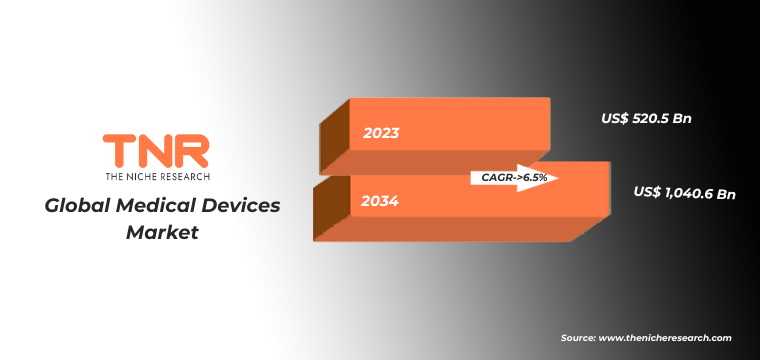
Global Medical devices Market Dynamics
Aging Population: The demographic shift towards an aging population worldwide increases the demand for medical devices catering to age-related health conditions such as cardiovascular diseases, orthopaedic disorders, and diabetes management. The rising prevalence of chronic diseases, such as cancer, diabetes, and respiratory disorders, fuels the demand for diagnostic and therapeutic medical devices, contributing significantly to market growth.
Emerging Markets Expansion: Growing healthcare infrastructure and increasing healthcare expenditure in emerging markets like China, India, and Brazil create lucrative opportunities for market expansion, driven by rising patient populations and improving access to healthcare services. The increasing adoption of minimally invasive surgical techniques drives the demand for specialized medical devices, such as laparoscopic instruments, endoscopes, and robotic-assisted surgical systems, contributing to market growth.
Patient-Centric Care: Increasing focus on patient-centric care and personalized medicine drives demand for medical devices that enable personalized diagnostics, treatment, and monitoring tailored to individual patient needs, fostering market growth. Global health crises such as the COVID-19 pandemic highlight the importance of medical devices in pandemic response, driving demand for diagnostic tests, ventilators, and other critical medical devices, leading to market expansion and innovation.
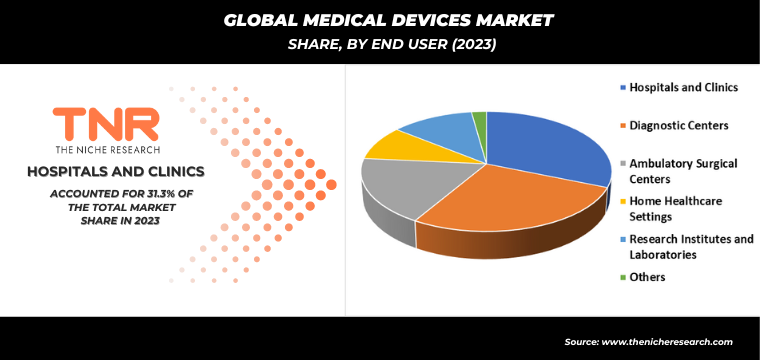
In Vitro Diagnostics Segment Has Garnered Major Market Share in the Global Medical Devices Market During the Forecast Period (2024 – 2034).
Technological advancements in IVD devices, including immunoassays, molecular diagnostics, and point-of-care testing platforms, enable more accurate, rapid, and sensitive detection of diseases. As the burden of chronic diseases such as cancer, diabetes, and infectious diseases rises globally, there is a heightened demand for IVD devices that can facilitate early detection, precise diagnosis, and effective disease management.
Moreover, the shift towards personalized medicine, driven by advancements in genomics and biomarker discovery, fuels the demand for IVD devices capable of providing tailored diagnostic and treatment approaches based on individual patient characteristics. Regulatory frameworks ensure the quality and reliability of IVD devices, instilling trust among healthcare providers and driving market demand for innovative diagnostic technologies that can improve patient outcomes and enhance healthcare delivery.
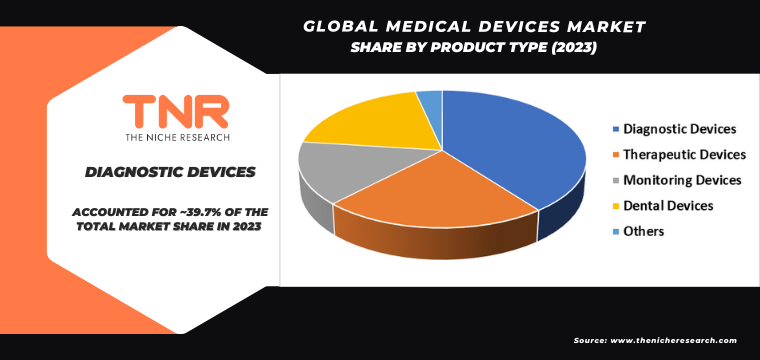
By Application Cardiology Segment had the Highest Share in the Global Medical Devices Market in 2023.
In the field of cardiology, the demand for medical devices is propelled by several key factors that address the specific needs of cardiovascular care. Technological advancements in medical device innovation, such as implantable cardioverter-defibrillators (ICDs), cardiac pacemakers, and stents, play a pivotal role in diagnosing, managing, and treating various cardiac conditions. As cardiovascular diseases remain a leading cause of mortality globally, there is a heightened demand for advanced medical devices that can effectively monitor cardiac activity, regulate heart rhythms, and restore blood flow to the heart.
Furthermore, demographic shifts, including an aging population and an increase in lifestyle-related risk factors, contribute to the rising prevalence of cardiovascular conditions, driving the need for innovative medical devices tailored to address age-related cardiovascular challenges. Additionally, stringent regulatory standards ensure the safety and efficacy of cardiology devices, fostering trust among healthcare professionals and patients alike, and further fuelling demand for cutting-edge medical technologies in the cardiology field.
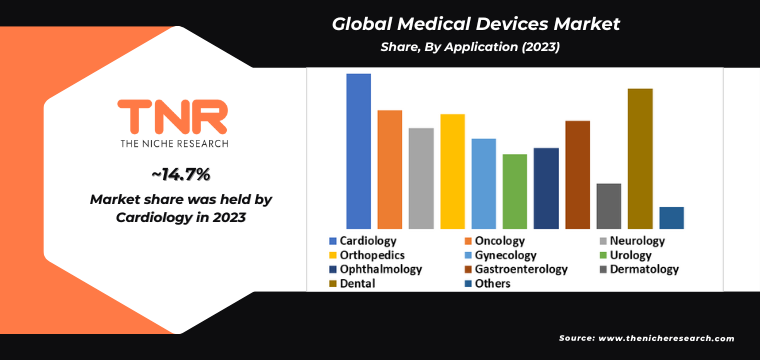
By Region, North America Dominated the Global Medical Devices Market in 2023.
In North America, the demand for medical devices is driven by several factors, including technological advancements, an aging population, and increasing healthcare expenditure. Technological innovations, such as wearable devices, remote monitoring systems, and minimally invasive surgical equipment, enhance patient care, improve treatment outcomes, and drive the adoption of advanced medical devices. The aging population in North America, coupled with the rising prevalence of chronic diseases, creates a growing demand for medical devices that can provide effective diagnostics, monitoring, and treatment options for elderly patients.
Additionally, the increasing healthcare expenditure in the region, driven by government investments, private sector initiatives, and insurance coverage, fuels the adoption of medical devices across various healthcare settings. Furthermore, regulatory frameworks, such as the FDA approval process, ensure the safety, efficacy, and quality of medical devices, instilling trust among healthcare providers and driving market demand for innovative medical technologies in North America.
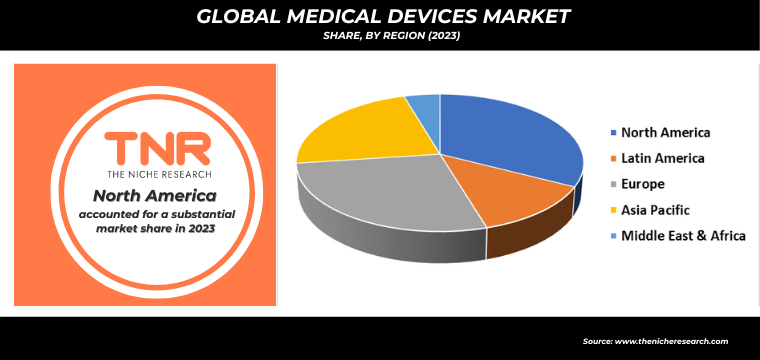
Competitive Landscape: Global Medical Devices Market:
- 3M
- Abbott
- Baxter
- BD
- Boston Scientific Corporation
- Cardinal Health
- DePuy Synthes
- Fresenius Medical Care AG
- GE Healthcare
- Koninklijke Philips N.V.
- Medtronic
- Olympus Corporation
- Siemens Healthcare Private Limited
- Stryker
- Terumo Medical Corporation
- Zimmer Biomet
- Other Market Participants
Global Medical Devices Market Scope
| Report Specifications | Details |
| Market Revenue in 2023 | US$ 520.5 Bn |
| Market Size Forecast by 2034 | US$ 1,040.6 Bn |
| Growth Rate (CAGR) | 6.5% |
| Historic Data | 2016 – 2022 |
| Base Year for Estimation | 2023 |
| Forecast Period | 2024 – 2034 |
| Report Inclusions | Market Size & Estimates, Market Dynamics, Competitive Scenario, Trends, Growth Factors, Market Determinants, Key Investment Segmentation, Product/Service/Solutions Benchmarking |
| Segments Covered | By Product Type, By Application, By End User, By Region |
| Regions Covered | North America, Europe, Asia Pacific, Middle East & Africa, Latin America |
| Countries Covered | U.S., Canada, Mexico, Rest of North America, France, The UK, Spain, Germany, Italy, Nordic Countries (Denmark, Finland, Iceland, Sweden, Norway), Benelux Union (Belgium, The Netherlands, Luxembourg), Rest of Europe, China, Japan, India, New Zealand, Australia, South Korea, Southeast Asia (Indonesia, Thailand, Malaysia, Singapore, Rest of Southeast Asia), Rest of Asia Pacific, Saudi Arabia, UAE, Egypt, Kuwait, South Africa, Rest of Middle East & Africa, Brazil, Argentina, Rest of Latin America |
| Key Players | 3M, Abbott, Baxter, BD, Boston Scientific Corporation, Cardinal Health, DePuy Synthes, Fresenius Medical Care AG, GE Healthcare, Koninklijke Philips N.V., Medtronic, Olympus Corporation, Siemens Healthcare Private Limited, Stryker, Terumo Medical Corporation, Zimmer Biomet |
| Customization Scope | Customization allows for the inclusion/modification of content pertaining to geographical regions, countries, and specific market segments. |
| Pricing & Procurement Options | Explore purchase options tailored to your specific research requirements |
| Contact Details | Consult With Our Expert
Japan (Toll-Free): +81 663-386-8111 South Korea (Toll-Free): +82-808- 703-126 Saudi Arabia (Toll-Free): +966 800-850-1643 United Kingdom: +44 753-710-5080 United States: +1 302-232-5106 E-mail: askanexpert@thenicheresearch.com
|
Global Medical Devices Market
By Product Type
- Diagnostic Devices
- Imaging Devices
- X-ray
- MRI
- CT Scan
- Ultrasound
- Others
- In Vitro Diagnostics
- Blood grouping devices
- Human genetic tests
- Immunoassays
- Next-generation sequencing tests
- COVID-19 tests
- Pregnancy tests
- Others
- Therapeutic Devices
- Cardiology Devices
- Orthopedic Devices
- Respiratory Devices
- Neurology Devices
- Diabetes Care Devices
- Surgical Devices
- Others
- Monitoring Devices
- Vital Sign Monitors
- Continuous Glucose Monitoring Systems
- Remote Patient Monitoring Devices
- Others
- Dental Devices
- Dental crowns
- Dental implant
- Dental bridge
- Dentures
- Dental veneers
- Others
- Imaging Devices
By Application
- Cardiology
- Oncology
- Neurology
- Orthopedics
- Gynecology
- Urology
- Ophthalmology
- Gastroenterology
- Dermatology
- Dental
- Others
By End User
- Hospitals and Clinics
- Diagnostic Centers
- Ambulatory Surgical Centers
- Home Healthcare Settings
- Research Institutes and Laboratories
- Others
By Region
- North America (U.S., Canada, Mexico, Rest of North America)
- Europe (France, The UK, Spain, Germany, Italy, Nordic Countries (Denmark, Finland, Iceland, Sweden, Norway), Benelux Union (Belgium, The Netherlands, Luxembourg), Rest of Europe)
- Asia Pacific (China, Japan, India, New Zealand, Australia, South Korea, Southeast Asia (Indonesia, Thailand, Malaysia, Singapore, Rest of Southeast Asia), Rest of Asia Pacific)
- Middle East & Africa (Saudi Arabia, UAE, Egypt, Kuwait, South Africa, Rest of Middle East & Africa)
- Latin America (Brazil, Argentina, Rest of Latin America)
Report Layout:
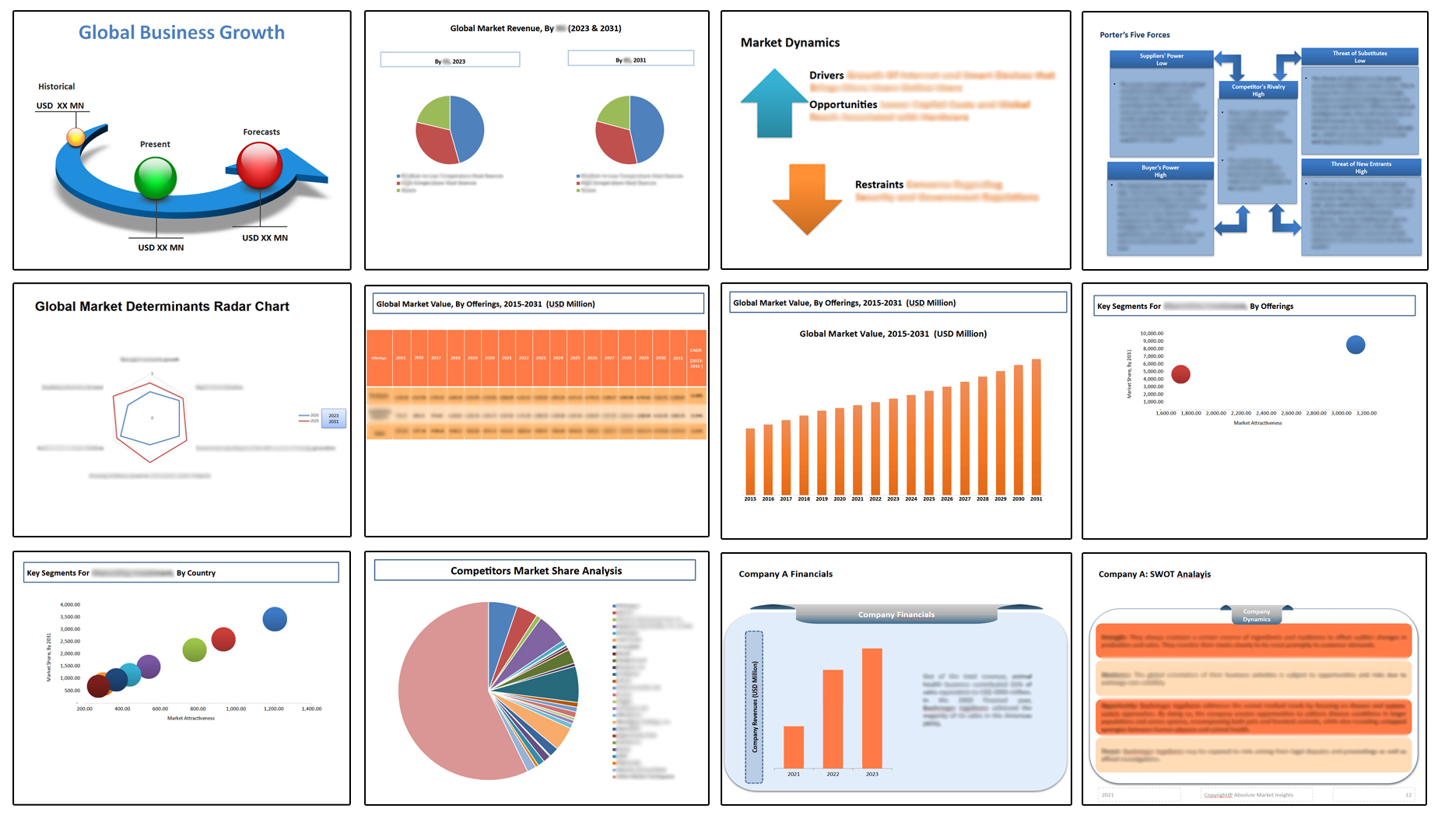
Table of Contents
Note: This ToC is tentative and can be changed according to the research study conducted during the course of report completion.
**Exclusive for Multi-User and Enterprise User.
Global Medical Devices Market
By Product Type
- Diagnostic Devices
- Imaging Devices
- X-ray
- MRI
- CT Scan
- Ultrasound
- Others
- In Vitro Diagnostics
- Blood grouping devices
- Human genetic tests
- Immunoassays
- Next-generation sequencing tests
- COVID-19 tests
- Pregnancy tests
- Others
- Therapeutic Devices
- Cardiology Devices
- Orthopedic Devices
- Respiratory Devices
- Neurology Devices
- Diabetes Care Devices
- Surgical Devices
- Others
- Monitoring Devices
- Vital Sign Monitors
- Continuous Glucose Monitoring Systems
- Remote Patient Monitoring Devices
- Others
- Dental Devices
- Dental crowns
- Dental implant
- Dental bridge
- Dentures
- Dental veneers
- Others
- Imaging Devices
By Application
- Cardiology
- Oncology
- Neurology
- Orthopedics
- Gynecology
- Urology
- Ophthalmology
- Gastroenterology
- Dermatology
- Dental
- Others
By End User
- Hospitals and Clinics
- Diagnostic Centers
- Ambulatory Surgical Centers
- Home Healthcare Settings
- Research Institutes and Laboratories
- Others
By Region
- North America (U.S., Canada, Mexico, Rest of North America)
- Europe (France, The UK, Spain, Germany, Italy, Nordic Countries (Denmark, Finland, Iceland, Sweden, Norway), Benelux Union (Belgium, The Netherlands, Luxembourg), Rest of Europe)
- Asia Pacific (China, Japan, India, New Zealand, Australia, South Korea, Southeast Asia (Indonesia, Thailand, Malaysia, Singapore, Rest of Southeast Asia), Rest of Asia Pacific)
- Middle East & Africa (Saudi Arabia, UAE, Egypt, Kuwait, South Africa, Rest of Middle East & Africa)
- Latin America (Brazil, Argentina, Rest of Latin America)
The Niche Research approach encompasses both primary and secondary research methods to provide comprehensive insights. While primary research is the cornerstone of our studies, we also incorporate secondary research sources such as company annual reports, premium industry databases, press releases, industry journals, and white papers.
Within our primary research, we actively engage with various industry stakeholders, conducting paid interviews and surveys. Our meticulous analysis extends to every market participant in major countries, allowing us to thoroughly examine their portfolios, calculate market shares, and segment revenues.
Our data collection primarily focuses on individual countries within our research scope, enabling us to estimate regional market sizes. Typically, we employ a bottom-up approach, meticulously tracking trends in different countries. We analyze growth drivers, constraints, technological innovations, and opportunities for each country, ultimately arriving at regional figures.Our process begins by examining the growth prospects of each country. Building upon these insights, we project growth and trends for the entire region. Finally, we utilize our proprietary model to refine estimations and forecasts.
Our data validation standards are integral to ensuring the reliability and accuracy of our research findings. Here’s a breakdown of our data validation processes and the stakeholders we engage with during our primary research:
- Supply Side Analysis: We initiate a supply side analysis by directly contacting market participants, through telephonic interviews and questionnaires containing both open-ended and close-ended questions. We gather information on their portfolios, segment revenues, developments, and growth strategies.
- Demand Side Analysis: To gain insights into adoption trends and consumer preferences, we reach out to target customers and users (non-vendors). This information forms a vital part of the qualitative analysis section of our reports, covering market dynamics, adoption trends, consumer behavior, spending patterns, and other related aspects.
- Consultant Insights: We tap into the expertise of our partner consultants from around the world to obtain their unique viewpoints and perspectives. Their insights contribute to a well-rounded understanding of the markets under investigation.
- In-House Validation: To ensure data accuracy and reliability, we conduct cross-validation of data points and information through our in-house team of consultants and utilize advanced data modeling tools for thorough verification.
The forecasts we provide are based on a comprehensive assessment of various factors, including:
- Market Trends and Past Performance (Last Five Years): We accurately analyze market trends and performance data from preceding five years to identify historical patterns and understand the market’s evolution.
- Historical Performance and Growth of Market Participants: We assess the historical performance and growth trajectories of key market participants. This analysis provides insights into the competitive landscape and individual company strategies.
- Market Determinants Impact Analysis (Next Eight Years): We conduct a rigorous analysis of the factors that are projected to influence the market over the next eight years. This includes assessing both internal and external determinants that can shape market dynamics.
- Drivers and Challenges for the Forecast Period:Identify the factors expected to drive market growth during the forecast period, as well as the challenges that the industry may face. This analysis aids in deriving an accurate growth rate projection.
- New Acquisitions, Collaborations, or Partnerships: We keep a close watch on any new acquisitions, collaborations, or partnerships within the industry. These developments can have a significant impact on market dynamics and competitiveness.
- Macro and Micro Factors Analysis:A thorough examination of both macro-level factors (e.g., economic trends, regulatory changes) and micro-level factors (e.g., technological advancements, consumer preferences) that may influence the market during the forecast period.
- End-User Sentiment Analysis: To understand the market from the end-user perspective, we conduct sentiment analysis. This involves assessing the sentiment, preferences, and feedback of the end-users, which can provide valuable insights into market trends.
- Perspective of Primary Participants: Insights gathered directly from primary research participants play a crucial role in shaping our forecasts. Their perspectives and experiences provide valuable qualitative data.
- Year-on-Year Growth Trend: We utilize a year-on-year growth trend based on historical market growth and expected future trends. This helps in formulating our growth projections, aligning them with the market’s historical performance.
Research process adopted by TNR involves multiple stages, including data collection, validation, quality checks, and presentation. It’s crucial that the data and information we provide add value to your existing market understanding and expertise. We have also established partnerships with business consulting, research, and survey organizations across regions and globally to collaborate on regional analysis and data validation, ensuring the highest level of accuracy and reliability in our reports.









